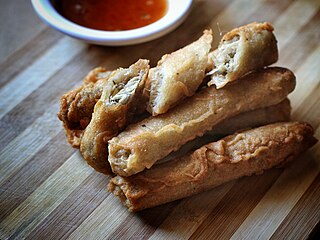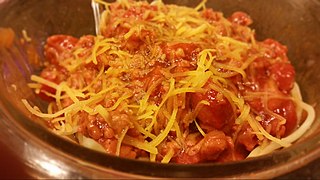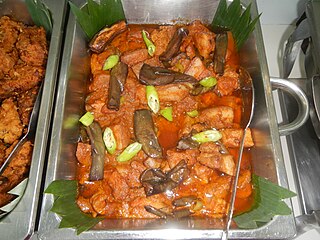
Fried rice is a dish of cooked rice that has been stir-fried in a wok or a frying pan and is usually mixed with other ingredients such as eggs, vegetables, seafood, or meat. It is often eaten by itself or as an accompaniment to another dish. Fried rice is a popular component of East Asian, Southeast Asian and certain South Asian cuisines, as well as a staple national dish of Indonesia. As a homemade dish, fried rice is typically made with ingredients left over from other dishes, leading to countless variations. Fried rice first developed during the Sui Dynasty in China.

Filipino cuisine is composed of the cuisines of more than a hundred distinct ethnolinguistic groups found throughout the Philippine archipelago. A majority of mainstream Filipino dishes that compose Filipino cuisine are from the food traditions of various ethnolinguistic groups and tribes of the archipelago, including the Ilocano, Pangasinan, Kapampangan, Tagalog, Bicolano, Visayan, Chavacano, and Maranao ethnolinguistic groups. The dishes associated with these groups evolved over the centuries from a largely indigenous base shared with maritime Southeast Asia with varied influences from Chinese, Spanish, and American cuisines, in line with the major waves of influence that had enriched the cultures of the archipelago, and adapted using indigenous ingredients to meet local preferences.

The generic term for condiments in the Filipino cuisine is sawsawan. Unlike sauces in other Southeast Asian regions, most sawsawan are not prepared beforehand, but are assembled on the table according to the preferences of the diner.

Picadillo is a traditional dish in many Latin American countries including Mexico and Cuba, as well as the Philippines. It is made with ground meat, tomatoes, and also raisins, olives, and other ingredients that vary by region. The name comes from the Spanish word picar, meaning "to mince".

Inihaw, also known as sinugba or inasal, are various types of grilled or spit-roasted barbecue dishes from the Philippines. They are usually made from pork or chicken and are served on bamboo skewers or in small cubes with a soy sauce and vinegar-based dip. The term can also refer to any meat or seafood dish cooked and served in a similar way. Inihaw are commonly sold as street food and are eaten with white rice or rice cooked in coconut leaves (pusô). Inihaw is also commonly referred to as Filipino barbecue or (informally) Pinoy BBQ.

Sinangag, also called garlic fried rice or garlic rice, is a Filipino fried rice dish cooked by stir-frying pre-cooked rice with garlic. The rice used is preferably stale, usually leftover cooked rice from the previous day, as it results in rice that is slightly fermented and firmer. It is garnished with toasted garlic, rock salt, black pepper and sometimes chopped scallions. The rice grains are ideally loose and not stuck together.

Ngohiong, also known and pronounced as ngoyong, is a Filipino appetizer consisting of julienned or cubed vegetables with ground meat or shrimp seasoned with five-spice powder in a thin egg crêpe that is deep-fried. It is a type of lumpia and is a Filipino adaptation of the Hokkien dish ngo hiang. It originates from Cebu City.

Pinatisan is a Filipino cooking process consisting of meat braised in patis, garlic, ginger, onion, black peppercorns, and bay leaves. Some recipes also add non-traditional ingredients like tomatoes, chili peppers, and other herbs and spices. Vinegar may also be added. It is very similar to binagoongan, which is made using fermented shrimp. It is also similar to Philippine adobo and paksiw, but is distinguished by the primary use of fish sauce in place of vinegar. Pinatisan has a strong umami flavor rather than the characteristic sour and sweet flavor of adobo.

Afritada is a Philippine dish consisting of chicken, beef, or pork braised in tomato sauce with carrots, potatoes, and red and green bell peppers. It is served on white rice and is a common Filipino meal. It can also be cooked with seafood.

Pininyahang manok, commonly anglicized as pineapple chicken, is a Philippine dish consisting of chicken braised in a milk or coconut milk-based sauce with pineapples, carrots, potatoes, and bell peppers. Some variants of the dish use a chicken stock base instead of milk. The dish originates from Southern Luzon which was once a regional center of pineapple fiber production in the Spanish Philippines.

Okoy or ukoy, are Filipino crispy deep-fried fritters made with glutinous rice batter, unshelled small shrimp, and various vegetables, including calabaza, sweet potato, cassava, mung bean sprouts, scallions and julienned carrots, onions, and green papaya. They are traditionally served with vinegar-based dipping sauces. They are eaten on their own or with white rice. They are popular for breakfast, snacks, or appetizers. Okoy are sometimes dyed bright orange with achuete seeds.

Ginataang kalabasa, also known as kalabasa sa gata, is a Filipino vegetable stew made from calabaza in coconut milk and spices. It commonly includes shrimp and yardlong beans and either bagoong or patis. It can also be cooked with fish, crab, or meat and a variety of other ingredients. It is a creamy umami-laden dish that is naturally slightly sweet due to the calabaza. It is a type of ginataan.

Filipino spaghetti is a Filipino adaptation of Italian spaghetti with Bolognese sauce. It has a distinctively sweet sauce, usually made from tomato sauce sweetened with brown sugar and banana ketchup. It is typically topped with sliced hot dogs or smoked longganisa sausages, giniling, and grated cheese. It is regarded as a comfort food in Philippine cuisine. It is typically served on almost any special occasion, especially on children's birthdays.

Lechon manok is a Filipino spit-roasted chicken dish made with chicken marinated in a mixture of garlic, bay leaf, onion, black pepper, soy sauce, and patis. The marinade may also be sweetened with muscovado or brown sugar. It is distinctively stuffed with tanglad (lemongrass) and roasted over charcoal. It is typically eaten dipped in a toyomansi or silimansi mixture of soy sauce, calamansi, and labuyo chilis. It is paired with white rice or puso and commonly served with atchara pickles as a side dish. It is a very popular dish in the Philippines and is readily available at roadside restaurants.

Binagoongan is a Filipino cooking process consisting of vegetables or meat sautéed or braised in bagoong alamang, garlic, black peppercorns, and bay leaves. Some recipes also add pineapples, chilis, or coconut cream to balance the flavors. The dish is characteristically quite salty with a strong umami flavor, which is why it is always paired with white rice and never eaten on its own. It is very similar to pinatisan which is cooked with patis, one of the by-products of fermenting bagoong.

Ginataang hipon is a Filipino seafood soup made from shrimp (hipon) in coconut milk (gata) and spices. It differs from other types of ginataan, in that it does not use vegetables. It is a type of ginataan. Variants of the dish include ginataang curacha and ginataang sugpo, which use spanner crabs and prawn, respectively, in place of shrimp.

Ginataang manok is a Filipino chicken stew made from chicken in coconut milk with green papaya and other vegetables, garlic, ginger, onion, patis or bagoong alamang, and salt and pepper. It is a type of ginataan. A common variant of the dish adds curry powder or non-native Indian spices and is known as Filipino chicken curry.
Bagoong fried rice, also known as binagoongan fried rice or anglicized as shrimp paste fried rice, is a Filipino fried rice dish cooked by stir-frying pre-cooked rice with sauteed bagoong alamang, toasted garlic, spring onions, shallots, julienned sour green mangoes, and optionally other ingredients like chilis, cucumbers, jicamas, carrots, scrambled eggs, chicharon, and tomatoes. It is usually light pink in color due to the use of angkak coloring agent from the bagoong. It is eaten paired with meat and seafood dishes, or is cooked with chunks of meat and seafood and eaten as is.
Kinamatisang manok, sometimes also known as sarciadong manok, is a Filipino stew made from chicken braised with tomatoes, siling mahaba, garlic, onion, bay leaves, fish sauce, black peppercorns, and usually carrots, potatoes, pechay, green peas, and/or green beans. It is very similar to chicken afritada and menudo, but differs in the ingredients and the fact that it is cooked with whole tomatoes rather than tomato sauce. The tomatoes used are the small and round indigenous tomato cultivars that are yellow to orange in color, giving the stew a rich orange color; but some modern recipes use commercial tomato sauce and tomato paste instead which results in a more reddish color. It is eaten served with white rice.


















